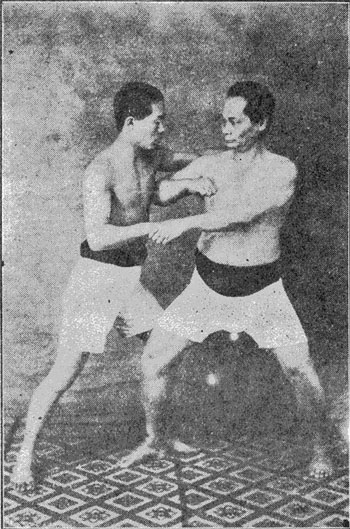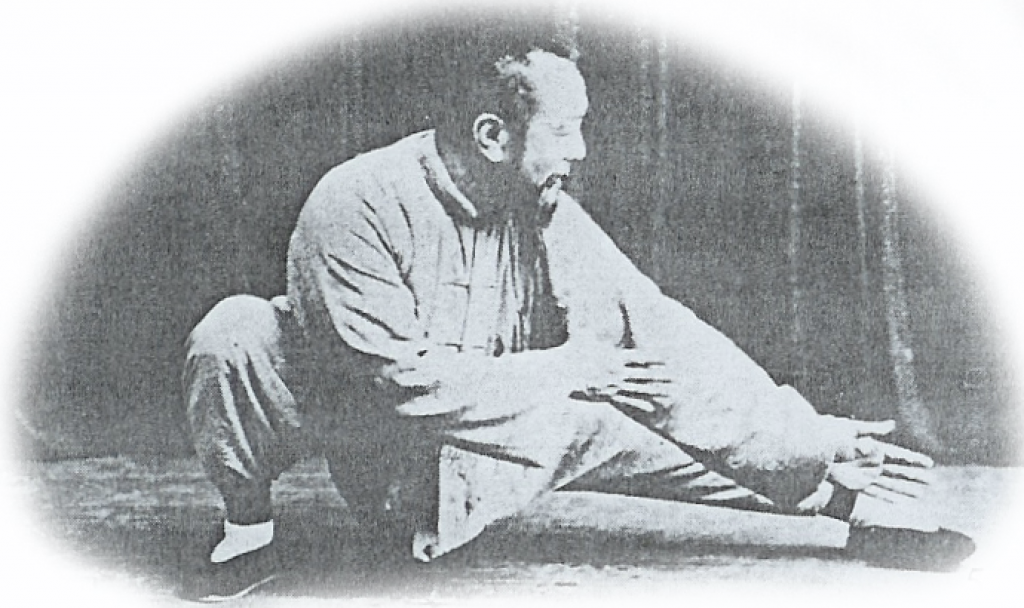(This article is the flip-side of a separate article – https://www.changeskill.com/2020/07/27/spirituality/ – both should be read in conjunction)
As a Tai Chi teacher, I’ve gone through different phases. At first, it was just trying to do what my teacher taught and told me. Like a lot of people, I started teaching Tai Chi because I moved cities and wanted people to practice with. My practice was (and is) fairly balanced, I would argue, with Kata and Kumite and Kihon (1) in more or less equal measure. The market was (and is) far more interested in the first of these, and I tried to cater for this in various ways. Moving to Australia, I decided not to bother trying to cater for the market, deciding to do things “my way”.

A bit of kumite (from wikipedia source in footnote). Looks like “zhou” in TCC.
I’ll write about “my way” at some other time. My thesis here is that “the market” wants fast-food nirvana, “Instant Tao”, and that flowing forms are taken to somehow constitute a panacea for health and well-being, spiritual advancement, and even martial prowess. I find it extremely annoying when people equate Tai Chi Ch’uan with forms … but that is utterly commonplace, including amongst those who should know better, as much now in 2020 as it was in the 1980s when my teacher started stirring things up in the UK.
It is understandable, and acceptable, that some students will want to focus more on one “K” than another. Regrettably, it always seems to be the first one. But surely what we really need is balance – at a lineage level, but also at a personal level. Whilst ensuring that the art is transmitted in its’ entirety, we should allow for personal directions and preferences. But whatever direction we take … it will require effort to even start approaching some modest competency.
The whole concept of ‘fast food’ is antithetical to ‘effort’. Contrary then to a key teaching in the Cheng Tin Hung lineage – the importance of “Gong”. So important that it is a core part of the mantra used in the internal training – aptly referred to as “nei gong”. “Gong” translates as “work”, and there’s a lot of it in traditional Tai Chi Ch’uan.

Tai Chi Gong starts (and finishes, to an extent) with the physical – the actual postures and movements, and, IMHO critically, the “fundamentals”: “jiben gong” (“basic training”). You’re supposed to kick – how high? Don’t you need to stretch and warm up? And if you were to kick a person … should you not prepare the body, perhaps by kicking a heavy bag? Just from the concept of “kick” (another K word), we head straight for Kumite and Kihon.
There is work and effort in Tai Chi Ch’uan, all the way along the journey. Cheng Tin Hung reportedly said “Tai Chi should never be easy”, but there are some variations in in where you put the work in, as you progress in your training. Once you’re able to kick to head height, there’s probably little to be achieved in stretching to kick higher. A solid, well-rooted, low horse-riding stance, that you can stay in for half-an-hour is probably enough. Nonetheless, the classics tell us that “Kung Fu is unceasing” (2) – and so the work will typically direct further inwards, depending on the student. Indeed, the “three coordinations” which I like to talk to students about as a matter of routine almost, was first brought to my attention in the section on nei gong in my teacher’s first book (3). Constant, directed work, putting forth effort, are the fundamentals for developing “Jin” (“competency” is the translation of choice here).

Putting in the work, making effort, showing “blood sweat and tears” – standard fare for martial arts, across those 3 Ks. It’s actually not about the pretty flowing forms that most people think define the art – they don’t; they are a result of the training. In this style of Tai Chi Ch’uan, the means condition the ends – you get the result, by doing the work. Anything else is vapourware and unworthy of your time and attention.
(1) From the Japanese – traditional Karate practice divides up into Kata (forms), Kumite (sparring/fighting/two person work) and Kihon (fundamentals). I like this because the words all start with ‘K’ … but also because this is a nice summary of what martial arts practice actually is. See https://en.wikipedia.org/wiki/Kumite
(2) From the “Song of the Thirteen Tactics” (“Shi San Shi Ge”) – Dan Docherty translates this as “Kung Fu (effort) is unceasing.” Nuance. See https://www.amazon.com.au/Tai-Chi-Chuan-Decoding-Classics/dp/1847970842/ref=sr_1_1?dchild=1&keywords=decoding+the+classics+for+the+modern+martial+artist&qid=1595833676&sr=8-1
(3) “Wutan Tai Chi Ch’uan” by Cheng Tin Hung and D.J. Docherty, 1983, reprinted 2010. https://www.amazon.com.au/Wutan-Tai-Chuan-Cheng-Hung/dp/1453604227/ref=sr_1_1?dchild=1&keywords=wutan+tai+chi+chuan&qid=1595833860&sr=8-1
1 Comment
Comments are closed.